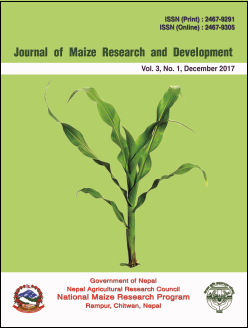Evaluation of early maize genotypes for grain yield and agromorphological traits
DOI:
https://doi.org/10.3126/jmrd.v3i1.18923Keywords:
Early maize genotypes, grain yield, agromorphological traitsAbstract
The purpose of this study was to assess the variation on agro-morphological traits and grain yield. A set of 14 early maize genotypes were studied at research field of Regional Agricultural Research Station (RARS), Doti, Nepal in summer seasons of 2015 and 2016. The experiment was carried out in Randomized Complete Block Design (RCBD) with three replications in each year. The variation among genotypes was observed for grain yield and flowering. The genotype SO3TEY-PO-BM produced the highest grain yield (4.33 t/ha) in 2015 whereas Rajahar Local Variety produced the highest grain yield (2.52 t/ha) in 2016. The combined analysis over years showed that Farmer’s variety was found earlier in tasseling (36 days) and silking (39 days), followed by S97TEYGHAYB(3) in tasseling (45 days) and by S97TEYGHAYB(3) and Arun-4 in silking (48 days). EEYC1 produced the highest grain yield (3.17 t/ha), followed by COMPOL-NIBP (3.09 t/ha), SO3TEY-PO-BM (2.90 t/ha), S97TEYGHAYB(3) (2.78 t/ha) and Rajahar Local variety (2.77 t/ha), respectively. The information on variation for the agro-morphological traits among studied early maize genotypes will be helpful to plant breeders in constructing their breeding materials and implementing selection strategies.




